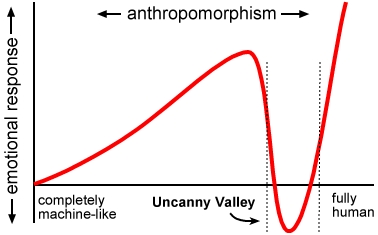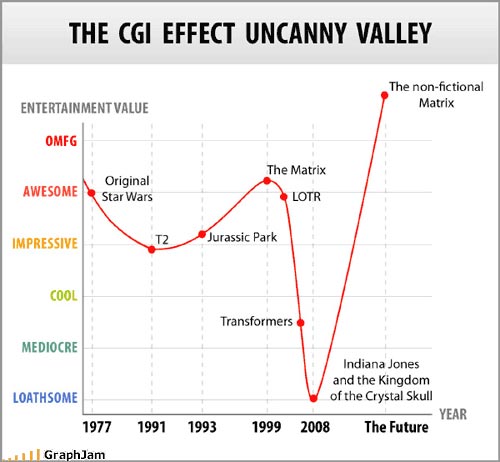Posted by Os Davis in films, motor sports, Review, Speed Racer, Sports | 0 Comments
Top Science Fiction Sports movies, no. 30: Speed Racer
 One of the key scientific theories of the 21st century is certain to be Masahiro Mori’s Bukimi no Tani Genshō, a.k.a. “The Uncanny Valley” Theory. The supposition suggests that as robots or animated objects more closely and closely approach a human form, the more likely there are to cause revulsion in a human observer until a great degree of realism exists.
One of the key scientific theories of the 21st century is certain to be Masahiro Mori’s Bukimi no Tani Genshō, a.k.a. “The Uncanny Valley” Theory. The supposition suggests that as robots or animated objects more closely and closely approach a human form, the more likely there are to cause revulsion in a human observer until a great degree of realism exists.
ESPN.com’s excellent Patrick Hruby applied the Uncanny Valley Theory to video games back in 2005 and, by inference, BuckBokai’s idol Gregg Easterbrook’s “The Progress Paradox: How Life Gets Better While People Feel Worse,” applied the idea to standards of living. Wikipedia informs us that the problem of the Uncanny Valley also helped kill box office for 3D computer animat[ed …] films Final Fantasy: The Spirits Within, The Polar Express, and Beowulf.
From Graph Jam via BoingBoing, here’s a visual depiction of same:
BuckBokai would like to add Speed Racer: The Movie Speed Racer to this chart, somewhat marginally above Indiana Jones and the Kingdom of the Crystal Skull.
(Incidentally, folks, let’s face it: The Wachowskis have been involved in the production of exactly two good films throughout their career – *and* they were kept away from directing responsibility on “V for Vendetta.”)
The truth is that, while we accept psychics-defying moves by machinery in cartoons and comic books – that’s what imagination is for – having it reproduced with real-life characters looks great for about 0.68 seconds, but then one is instantly amazed at how tedious endless shots of 270º degree turns gets. Though the Wachowskis follow the rules of f/x in big-budget flicks to a T (and really there’s only one rule: Just keep upping the effects until the denouement), by the second reel nothing is amazing or new about any of the impossible flips and turns undertaken on four wheels or two.
In terms of sport, Speed Racer: The Movie suffers from a like problem of Pixar’s Cars series. To wit: Do the kiddies actually give a Mickey Mouse’s ass about the business side of the sport? While precocious fans of NASCAR may understand what the pit crews are all about in the same way that some very young fans of American football can explain the importance of offensive linemen, do any of them really care about the transactions-and-acquisitions of boardroom types? All that money-manipulating doublespeak is nothing but a turnoff to any non-Ferengi youth, to be sure.
Of course Speed Racer: The Movie is expressly not a kid’s movie, right? Even beyond all the talk-talk-talk of the family (more on this momentarily), the Wachshowskis manage to throw in a handful of four-letter words to pump up that rating a bit. What’s particularly egregious about this, then, is the utterly unnecessary inclusion of the dumbass monkey-and-cute-kid schtick: Why is this even included in the movie at all? Is it a formula? You know, like, three utterances of “shit” is counterbalanced with 32 minutes of screen time for a primate of under four feet in height?
In the parlance of our times, WTF gives with this bizarre contradiction?
Then there’s the inevitable Americanization process. Years before M. Night Shyamalan took degrees of heat (and concomitant box-office hit) for bleaching the cast of The Last Airbender, the Wachowskis turned the simple Japanese family drama aspects of Speed Racer into nauseatingly drippy over-simplistic American graffiti. John Goodman and Susan Sarandon, despite contributing amazingly real performances that belong in another movie, cannot save this unforgivable pap. (And hey, if you don’t believe the red, white and blue nuclear family will be preserved by final credits, you just don’t watch movies.)
Clichéd filmmaking trying to be all things to all people whilst simultaneously sterilizing what was an endlessly fascinatingly open cartoon series through the overwhelming realism “demanded” by “modern” film audiences: Speed Racer deserved better than to be left to perish in the cold uncanny valley.
But it was.


